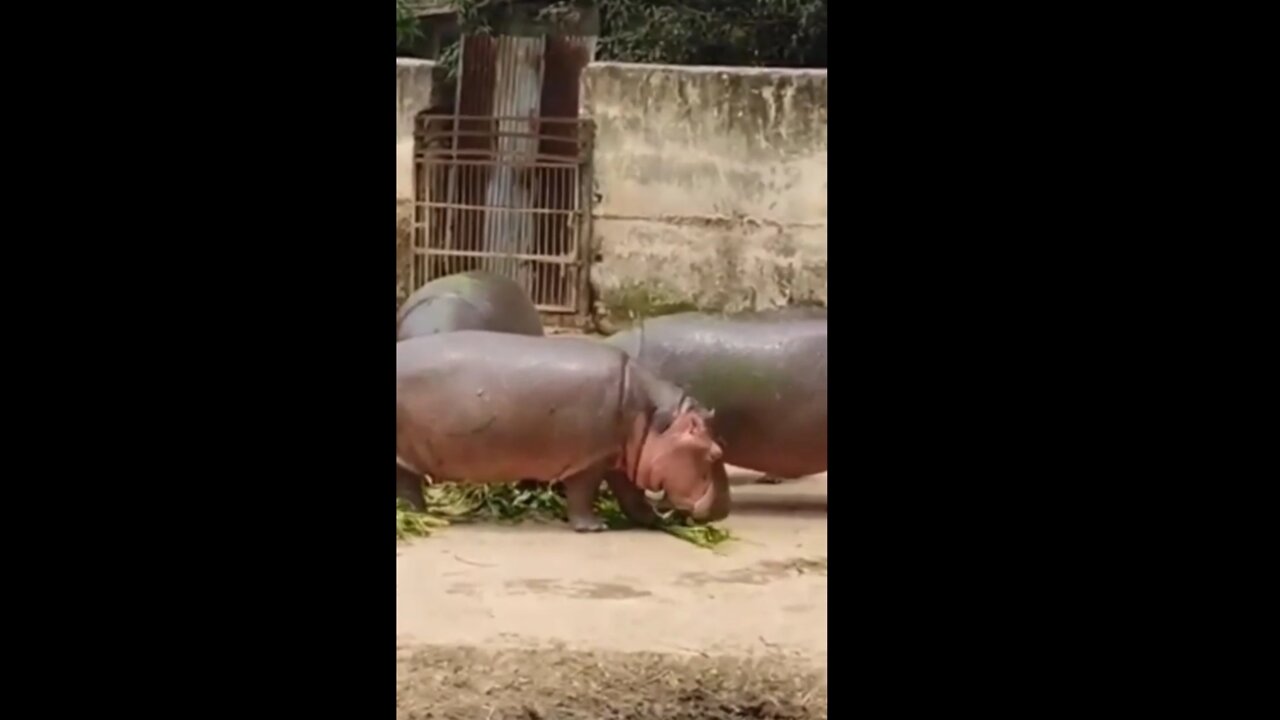Premium Only Content

Hippocampus eting gress.
The hippopotamus (/ˌhɪpəˈpɒtəməs/ HIP-ə-POT-ə-məs;[3] Hippopotamus amphibius), also called the hippo, common hippopotamus, or river hippopotamus, is a large semiaquatic mammal native to sub-Saharan Africa. It is one of only two extant species in the family Hippopotamidae, the other being the pygmy hippopotamus (Choeropsis liberiensis or Hexaprotodon liberiensis). Its name comes from the ancient Greek for "river horse" (ἱπποπόταμος).
HippopotamusA hippopotamus in Saadani National Park, Tanzania
Conservation status

Vulnerable (IUCN 3.1)[1]
CITES Appendix II (CITES)[1]
Scientific classificationKingdom:AnimaliaPhylum:ChordataClass:MammaliaOrder:ArtiodactylaFamily:HippopotamidaeGenus:HippopotamusSpecies:
H. amphibius
Binomial nameHippopotamus amphibius
Linnaeus, 1758[2]
Range map of the hippopotamus. Historic range is in red while current range is in green.[1]
Aside from elephants and rhinos, the hippopotamus is the largest land mammal. It is also the largest extant land artiodactyl. Despite their physical resemblance to pigs and other terrestrial even-toed ungulates, the closest living relatives of the Hippopotamids are cetaceans (whales, dolphins, porpoises, etc.), from which they diverged about 55 million years ago. Hippos are recognisable for their barrel-shaped torsos, wide-opening mouths with large canine tusks, nearly hairless bodies, pillar-like legs, and large size: adults average 1,500 kg (3,310 lb) for bulls (males) and 1,300 kg (2,870 lb) for cows (females). Despite its stocky shape and short legs, it is capable of running 30 km/h (19 mph) over short distances.
Hippos inhabit rivers, lakes, and mangrove swamps. Territorial bulls each preside over a stretch of water and a group of five to thirty cows and calves. Reproduction and birth both occur in the water. During the day, hippos remain cool by staying in water or mud, emerging at dusk to graze on grasses. While hippos rest near each other in the water, grazing is a solitary activity and hippos typically do not display territorial behaviour on land. Hippos are among the most dangerous animals in the world due to their highly aggressive and unpredictable nature. They are threatened by habitat loss and poaching for their meat and ivory (canine teeth).
-
 1:27
1:27
Animals Planet
2 years ago10 minutes after birth kittens meow loudly.
3381 -
 2:03:55
2:03:55
Badlands Media
2 hours agoDevolution Power Hour Ep. 382
79.9K10 -
 2:06:30
2:06:30
Inverted World Live
6 hours agoDon't Approach the Zombie Rabbits | Ep. 95
27.5K10 -
 LIVE
LIVE
Drew Hernandez
2 hours agoISRAEL PLANNING POSSIBLE DRAFT IN USA & TRUMP'S VIEW ON ETERNAL LIFE ANALYZED
1,232 watching -
 3:08:07
3:08:07
TimcastIRL
5 hours agoTexas Republicans Win, House Passes Redistricting Map, GOP Looks To Gain 5 Seats | Timcast IRL
157K60 -
 1:30:34
1:30:34
FreshandFit
5 hours agoHow To Stay Focused While Pursuing Women...The Good, The Bad, And The Ugly
41.4K20 -
 1:47:05
1:47:05
Drew Hernandez
9 hours agoISRAEL PLANNING POSSIBLE DRAFT IN USA & TRUMP'S VIEW ON ETERNAL LIFE ANALYZED
26.4K55 -
 29:55
29:55
Afshin Rattansi's Going Underground
3 days agoProf. Omer Bartov: The REAL REASON the US, UK, and EU Have Not Recognised Israel’s Genocide in Gaza
23.6K26 -
 LIVE
LIVE
SpartakusLIVE
7 hours agoWednesday WZ with the Challenge MASTER || Duos w/ GloryJean
427 watching -
 2:36:12
2:36:12
Barry Cunningham
6 hours agoREACTING TO STEPHEN MILLER | KASH PATEL | TULSI GABBARD INTERVIEWS AND MORE NEWS!
72.2K67